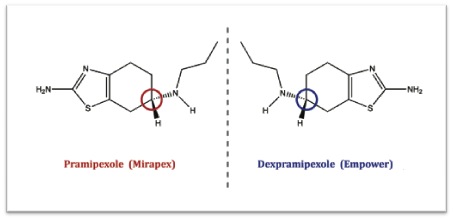
Mirror mirror on the lab bench. Researchers found that the so-called enantiomer (mirror image) of the Parkinson’s drug pramipexol (red), dexpramipexole (blue), is well tolerated. Scientists suspect that this is because the drug is unable to overstimulate the dopamine receptors in the brain reducing unwanted side effects such as severe nausea, sleeplessness and hallucinations.
Knopp Biosciences’ experimental drug dexpramipexole may slow the progression of amyotrophic lateral sclerosis (ALS) according to a new study published this week.
The placebo-controlled phase II clinical trial, led by Massachusetts General Hospital neurologist Merit Cudkowicz MD MSc, found that in just 12 weeks, people taking 300mg of the drug daily progressed 31% slower than those on placebo. 102 ALS patients participated.
This is the largest reduction in motor function decline observed in people with ALS in a clinical trial at the phase II stage.
“These results came out more positive that we could have expected,” says senior author and Knopp Biosciences’ Chief Scientific Adviser Valentin Gribkoff PhD.
The drug, now licensed to Biogen Idec, is being tested at the phase III stage in about 800 patients at 81 sites worldwide.
Researchers at the University of Virginia first looked toward the highly related drug pramipexole (Miraprex) to treat ALS in 2003 because of its ability to protect neurons from degenerating in people with Parkinson’s disease. The scientists later switched to dexpramipexole suspecting that the drug might be safer and exhibit fewer side effects.
The phase II trial took place in two parts. The first 12 weeks, patients were given daily 50, 150, 300mg or placebo and after 4 weeks of ”washout”, 24 weeks of either 50mg or 300mg.
Dexpramipexole appeared to be safe and well-tolerated according to the phase II results. The reduction in decline of motor function was dose-dependent and highest at the 300 mg dose. And after 24 weeks, the risk of death dropped significantly between those on 300mg and 50mg of drug.
“If this is to hold true in a larger study, these are all clinically significant levels of benefit,” says Gribkoff.
Power Up
Scientists suspect that neuroprotective agents such as dexpramipexole may help ALS patients retain muscle function by keeping the energy flowing in degenerating motor nerves, slowing the progression of the disease. Other drugs that may strengthen mitochondria include Trophos’ olesoxime which is currently being evaluated at the phase III stage in Europe.
The FDA fast-tracked dexpramipexole in 2009 due to the need for a more effective treatment for ALS. The initial results for the phase III trial are expected sometime in 2013.
To learn more about the role of mitochondria in ALS, read ALS, More Than A Power Play.
Reference
Cudkowicz, M. et al. (2011) The effects of dexpramipexole (KNS-760704) in individuals with amyotrophic lateral sclerosis. Nature Medicine. doi: 10.1038/nm 2579 Abstract | Full Text (Subscription Required)
Further Reading
Gribkoff, V.K. and Bozik, M.E. (2008) KNS-760704 [(6R)-4,5,6,7-tetrahydro-N6-propyl-2,6-benzothiazole-diamine dihydrochloride monohydrate] for the Treatment of Amyotrophic Lateral Sclerosis CNS Neuroscience and Therapeutics, 14, 215-226. Abstract | Full Text (Subscription Required)
CORRECTION: Patients were administered during the first 12 weeks a total of 50mg, 150mg, 300mg dexpramipexole or placebo and after 4 weeks "washout" for 24 weeks, a total of 50mg or 300mg of the drug.